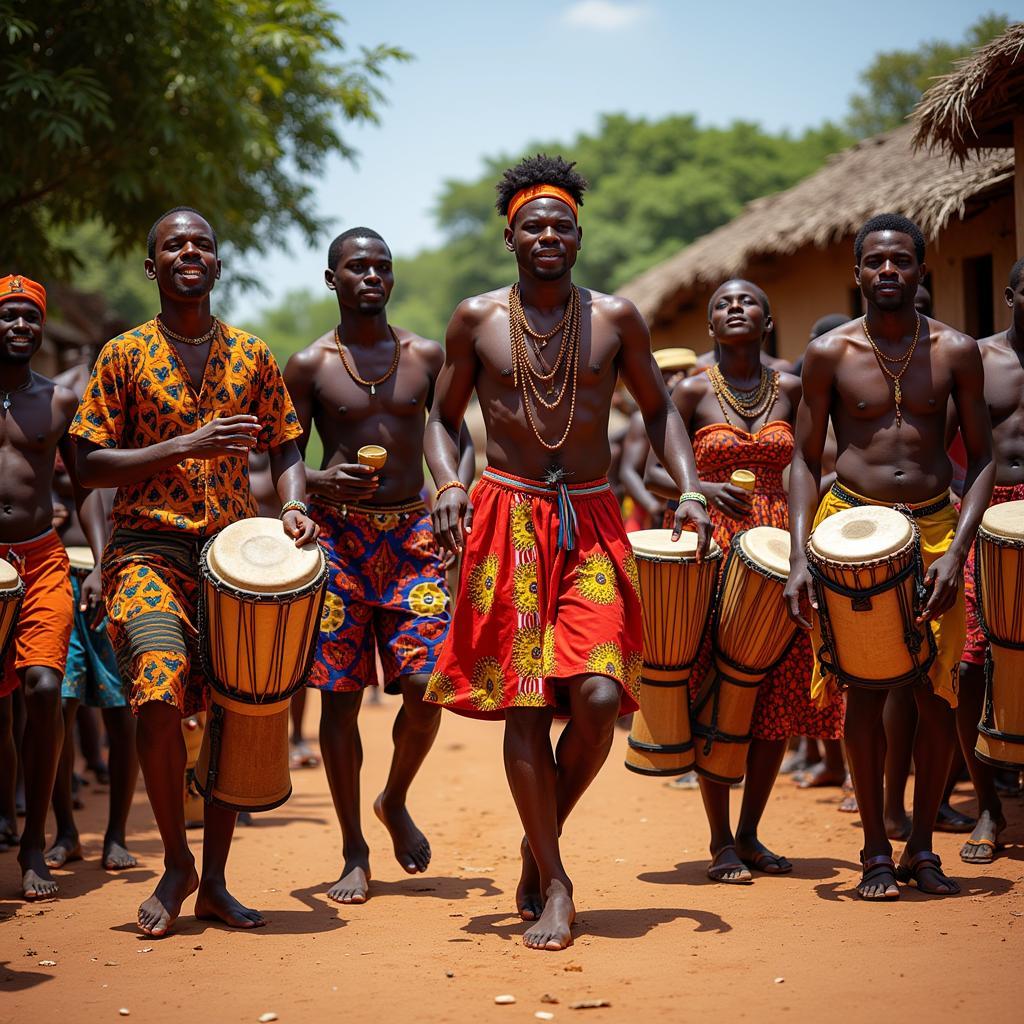The African Elephant: A Journey Through History
The African elephant, an iconic symbol of the continent’s grandeur, boasts a history as rich and vast as the savannas it roams. From ancient myths to modern conservation efforts, the African elephant’s story is interwoven with the very fabric of African Life. Understanding their history is crucial to appreciating their present and safeguarding their future.
Giants of the Savanna: Tracing the African Elephant’s Lineage
Fossil evidence suggests that the ancestors of elephants originated in Africa around 55 million years ago. These early proboscideans, smaller than their modern descendants, gradually evolved over millennia, giving rise to the mammoths and mastodons that once roamed the Earth. The African elephant, as we know it today, emerged around 2 million years ago, adapting to the diverse habitats of the continent.
Two Species, One Ancestry: Unveiling the Differences
While they share a common ancestor, the African elephant is not a monolithic entity. There are actually two distinct species: the African savanna elephant (Loxodonta africana) and the African forest elephant (Loxodonta cyclotis).
- African savanna elephant: Larger, with wider ears and upward-curving tusks, these elephants are a familiar sight on the open grasslands.
- African forest elephant: Smaller, with straighter tusks and darker skin, these elusive creatures navigate the dense rainforests of Central Africa.
Despite their differences, both species play a vital role in maintaining the ecological balance of their respective habitats.
A Legacy Etched in Culture: The Elephant in African Societies
Throughout history, the African elephant has held a place of reverence and significance in African cultures. From ancient rock art depicting elephant hunts to elaborate ceremonies honoring their spirits, the elephant has been an integral part of the cultural tapestry of numerous African societies.
Symbols of Power and Wisdom: Elephants in Mythology and Folklore
In many African cultures, elephants are revered as symbols of strength, wisdom, and longevity. They feature prominently in mythology and folklore, often depicted as wise chiefs, powerful guardians, or even tricksters. These stories often carry moral lessons about respect for nature, the importance of community, and the consequences of greed.
african american christmas sayings
Ivory, Trade, and Decline: The Dark Side of Human-Elephant Interactions
The relationship between humans and elephants, however, has not always been harmonious. The ivory trade, driven by demand for this precious material, cast a long shadow over the African elephant’s history.
A Brutal Chapter: The Impact of the Ivory Trade
From the Roman Empire to the Victorian era, ivory from African elephants was highly sought after, leading to widespread hunting and decimation of elephant populations. While international efforts have banned the ivory trade, poaching remains a persistent threat, driven by illegal markets and organized crime.
Conservation Efforts: A Race Against Time
Today, conservationists, governments, and local communities are working tirelessly to protect the remaining African elephant populations.
Protecting a Heritage: Strategies for the Future
Efforts include:
- Anti-poaching patrols: Rangers on the ground combat illegal hunting activities.
- Habitat protection: Creating and maintaining protected areas ensures safe havens for elephants.
- Community-based conservation: Engaging local communities in conservation initiatives fosters sustainable co-existence.
These efforts, though challenging, offer hope for the future of the African elephant.
Conclusion: Securing a Future for Giants
The African elephant’s story is a poignant reminder of the interconnectedness of all living beings. By understanding their past, supporting conservation efforts, and advocating for their protection, we can help ensure that these magnificent creatures continue to roam the African landscape for generations to come. Their future, much like their past, is inextricably linked to our own.
FAQs about African Elephant History
What is the earliest known ancestor of the African elephant?
Fossil evidence suggests that the earliest known ancestors of elephants, known as proboscideans, originated in Africa around 55 million years ago.
What is the main difference between the African savanna elephant and the African forest elephant?
The African savanna elephant is larger with wider ears and upward-curving tusks, while the African forest elephant is smaller with straighter tusks and darker skin.
Why were African elephants hunted for their ivory?
Ivory from African elephants has been a highly valued material for centuries, used to create art, jewelry, and other luxury items.
What is being done to protect African elephants today?
Conservation efforts include anti-poaching patrols, habitat protection, and community-based conservation initiatives.
african american family christmas pictures
Understanding the African Elephant: Further Exploration
- The Role of Elephants in Their Ecosystem: Explore the ecological significance of African elephants and their impact on the environment.
- The Ethics of Elephant Tourism: Delve into the complexities of elephant tourism and its impact on conservation efforts.
- Supporting Ethical Elephant Sanctuaries: Learn how to identify and support ethical elephant sanctuaries that prioritize animal welfare.
african american nativity scene pictures
For any assistance or inquiries, feel free to contact us:
Phone Number: +255768904061
Email: [email protected]
Address: Mbarali DC Mawindi, Kangaga, Tanzania.
Our dedicated customer support team is available 24/7 to assist you.


